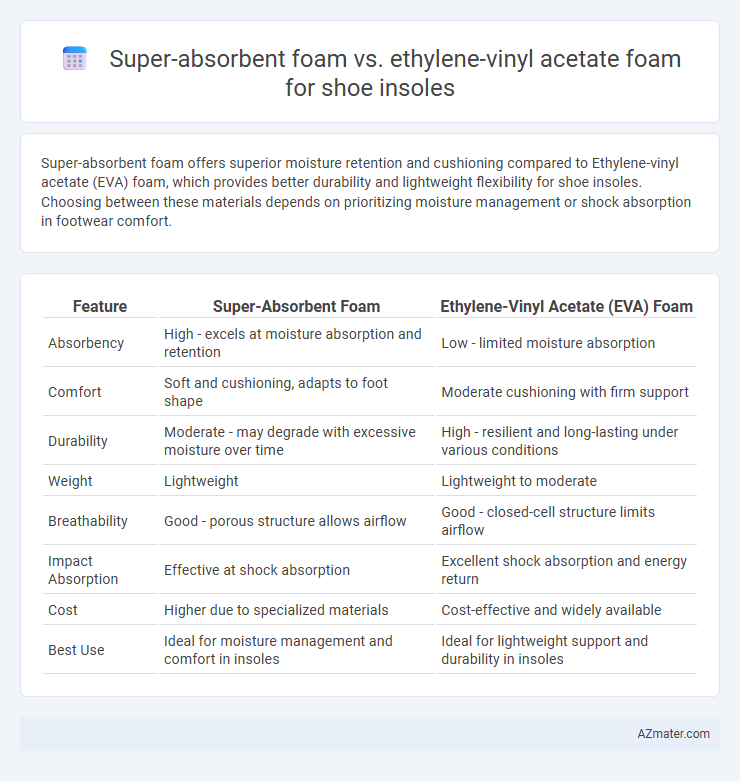Super-absorbent foam offers superior moisture retention and cushioning compared to Ethylene-vinyl acetate (EVA) foam, which provides better durability and lightweight flexibility for shoe insoles. Choosing between these materials depends on prioritizing moisture management or shock absorption in footwear comfort.
Table of Comparison
| Feature | Super-Absorbent Foam | Ethylene-Vinyl Acetate (EVA) Foam |
|---|---|---|
| Absorbency | High - excels at moisture absorption and retention | Low - limited moisture absorption |
| Comfort | Soft and cushioning, adapts to foot shape | Moderate cushioning with firm support |
| Durability | Moderate - may degrade with excessive moisture over time | High - resilient and long-lasting under various conditions |
| Weight | Lightweight | Lightweight to moderate |
| Breathability | Good - porous structure allows airflow | Good - closed-cell structure limits airflow |
| Impact Absorption | Effective at shock absorption | Excellent shock absorption and energy return |
| Cost | Higher due to specialized materials | Cost-effective and widely available |
| Best Use | Ideal for moisture management and comfort in insoles | Ideal for lightweight support and durability in insoles |
Overview of Super-Absorbent and Ethylene-Vinyl Acetate Foams
Super-absorbent foam for shoe insoles is engineered to absorb and retain moisture efficiently, enhancing foot comfort by managing sweat and reducing odor. Ethylene-vinyl acetate (EVA) foam provides lightweight cushioning, shock absorption, and durability, making it a popular choice for supportive insoles. Both materials offer distinct benefits, with super-absorbent foam excelling in moisture control and EVA foam delivering superior resilience and impact protection.
Material Composition and Structure Comparison
Super-absorbent foam for shoe insoles typically consists of hydrophilic polymers like sodium polyacrylate, designed to rapidly absorb and retain moisture within a porous, cross-linked network structure. Ethylene-vinyl acetate (EVA) foam is a copolymer composed of ethylene and vinyl acetate, featuring a closed-cell, flexible matrix that provides cushioning and durability but lacks high moisture absorption capability. The fundamental difference lies in super-absorbent foam's open-cell, moisture-retentive composition versus EVA's closed-cell, hydrophobic structure optimized for shock absorption and resilience.
Cushioning and Shock Absorption Properties
Super-absorbent foam offers superior moisture retention and cushioning, providing enhanced shock absorption by dispersing impact forces effectively during activities. Ethylene-vinyl acetate (EVA) foam delivers durable, lightweight support with moderate cushioning and elasticity, maintaining consistent shock absorption over prolonged use. Comparing both, super-absorbent foam excels in moisture management and comfort, while EVA foam is preferred for its balance of shock absorption, resilience, and long-term stability in shoe insoles.
Moisture Management and Breathability
Super-absorbent foam in shoe insoles excels in moisture management by actively absorbing and retaining sweat, reducing foot dampness and preventing odor buildup. Ethylene-vinyl acetate (EVA) foam, known for its lightweight and flexible structure, offers superior breathability, allowing air circulation to keep feet dry and comfortable. Combining the moisture-wicking properties of super-absorbent foam with the ventilated design advantage of EVA foam can enhance overall foot hygiene and comfort in footwear.
Durability and Wear Resistance
Super-absorbent foam offers superior moisture management but tends to have lower durability and wear resistance compared to Ethylene-vinyl acetate (EVA) foam, which provides excellent resilience and long-lasting performance under repeated compression. EVA foam maintains structural integrity over extended use, making it ideal for shoe insoles exposed to rigorous daily wear. The material's ability to resist deformation and abrasion ensures enhanced longevity and sustained comfort during prolonged activities.
Weight and Flexibility Factors
Super-absorbent foam offers superior moisture management and is typically lighter than Ethylene-vinyl acetate (EVA) foam, enhancing overall shoe comfort. EVA foam provides excellent flexibility and shock absorption but usually weighs more due to its denser polymer structure. Weight-sensitive applications favor super-absorbent foam for lightweight cushioning, while EVA remains preferred for durable, flexible support in insoles.
Odor Control and Hygiene Benefits
Super-absorbent foam in shoe insoles excels at moisture management by rapidly trapping sweat, which helps reduce bacterial growth and odor formation, thus enhancing hygiene. Ethylene-vinyl acetate (EVA) foam offers moderate moisture resistance but lacks the high absorbency needed to prevent odor-causing bacteria effectively. For superior odor control and long-term foot hygiene, super-absorbent foam provides a more efficient barrier against moisture and microbial proliferation compared to traditional EVA foam insoles.
Environmental Impact and Sustainability
Super-absorbent foam offers enhanced moisture management and is often engineered from biodegradable polymers, reducing environmental footprint compared to traditional materials. Ethylene-vinyl acetate (EVA) foam, widely used in shoe insoles, is derived from petrochemicals and presents challenges in recycling and biodegradability, contributing to long-term environmental pollution. Sustainable alternatives focus on bio-based or recycled EVA formulations, but super-absorbent foams with natural components demonstrate superior potential in minimizing ecological impact and promoting circular economy principles.
Cost Analysis and Market Availability
Super-absorbent foam offers superior moisture retention and cushioning but tends to be more expensive due to advanced polymer technology and limited large-scale production. Ethylene-vinyl acetate (EVA) foam provides cost-effective cushioning with widespread market availability, benefiting from established manufacturing processes and broad supplier networks. The price difference significantly impacts affordability for mass-market insoles, while EVA remains the dominant choice for budget-conscious consumers and high-volume production.
Best Choice for Different Footwear Applications
Super-absorbent foam offers exceptional moisture-wicking properties ideal for athletic shoes and outdoor footwear, providing enhanced comfort and odor control during intense activities. Ethylene-vinyl acetate (EVA) foam, known for its lightweight cushioning and superior shock absorption, is preferred in casual and running shoes where durability and flexibility are essential. Choosing between super-absorbent foam and EVA depends on the specific footwear application, with super-absorbent foam excelling in moisture management and EVA delivering balanced support and resilience.

Infographic: Super-absorbent foam vs Ethylene-vinyl acetate foam for Shoe insole
 azmater.com
azmater.com